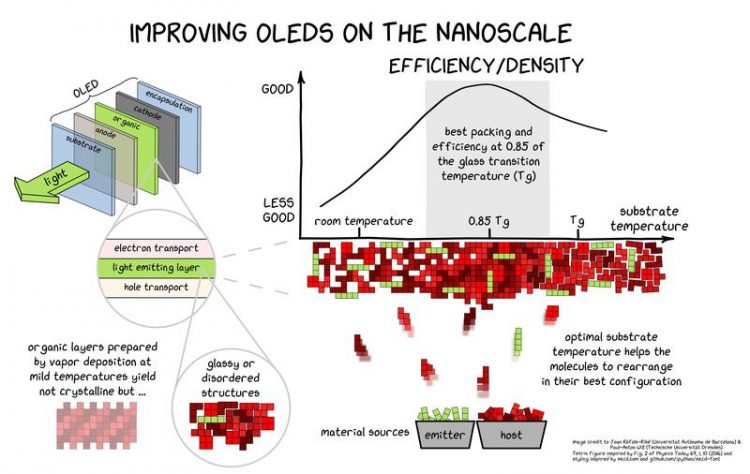Organic light-emitting diodes become brighter and more durable

Illustration summarizing the nanoscale difference of ultrastable glasses compared to conventional ones Joan Ráfols-Ribe, Paul-Anton Will
Now, researchers from the Universitat Autònoma de Barcelona and Technische Universität Dresden have demonstrated the possibility of using ultrastable film formation to improve the performance of state-of-the-art OLEDs.
In their joint paper published in Science Advances with the title ‘High-performance organic light-emitting diodes comprising ultrastable glass layers’, the researchers show in a detailed study that significant increases of efficiency and operational stability (> 15% for both parameters and all cases, significantly higher for individual samples) are achieved for four different phosphorescent emitters.
To achieve these results, the emission layers of the respective OLEDs were grown as ultrastable glasses – a growth condition that allows for thermodynamically most stable amorphous solids.
Illustration summarizing the nanoscale difference of ultrastable glasses compared to conventional ones and the impact on the layer and device properties of organic light-emitting diodes (OLEDs).
This finding is significant, because it is an optimization which involves neither a change of materials used nor changes to the device architecture. Both are the typical starting points for improvements in the field of OLEDs. This concept can be universally explored in every given specific OLED stack, which will be equally appreciated by leading industry.
This in particular includes thermally activated delayed fluorescence (TADF) OLEDs, which are seeing tremendous research and development interest at the moment. Furthermore, the improvements that, as shown by the researchers, can be tracked back to differences in the exciton dynamics on the nanoscale suggest that other fundamental properties of organic semiconductors (e.g. transport, charge separation, energy transfer) can also be equally affected.
The research leading to these results was partly carried out in the project ‘Modelling stability of organic phosphorescent light-emitting diodes (MOSTOPHOS)’ funded by the European Union’s Horizon 2020 research and innovation programme (grant agreement no. 646259). Currently, this concept is being explored together with cynora GmbH, a MOSTOPHOS partner and a world-leading company in development of TADF emitters.
Publication: J. Ràfols-Ribé, P.-A. Will, C. Hänisch, M. González-Silveira, S. Lenk, J. Rodríguez-Viejo, S. Reineke, High-performance organic light-emitting diodes comprising ultrastable glass layers. Sci. Adv. 4, eaar8332 (2018).
About the Group of Nanomaterials and Microsystems (GNaM): GNaM is part of the Physics Department at the Universitat Autònoma de Barcelona and led by Prof. Javier Rodríguez-Viejo. The group has been deeply involved in the growth and characterization of stable organic glasses, focusing on their thermal, thermodynamic and transport properties.
Due to their unique properties including among others higher densities, better kinetic and thermodynamic stabilities and higher modulus, stable glasses are presently at the core of the research in the glass community providing a unique framework for a better comprehension of the glassy state and new opportunities for applications. GNaM is also developing new tools to characterize thermoelectric properties of low-dimensional and disordered solids and has recently founded a start-up company, FutureSisens, for the commercialization of Si-based thermoelectric sensors.
About the Light-Emitting and eXcitonic Organic Semiconductor (LEXOS) group: The LEXOS group is part of the Dresden Integrated Center for Applied Physics and Photonics Materials (IAPP) and the Institute of Applied Physics of the Technische Universität Dresden and led by Prof. Sebastian Reineke. The LEXOS group has long-standing expertise in the research and development of organic light-emitting diodes (OLEDs).
The current OLED research comprises stack and concept development, devices optics, charge transport and recombination studies, long-term stability investigations, material development (dopant and emitter materials), and device integration. A second research focus of the LEXOS group is the investigation of excitonic and luminescent systems covering organic and other related emerging materials.
The group has strong expertise in the optical spectroscopy of such systems. One current example is the investigation of organic biluminescence, where luminophores show both fluorescence and phosphorescence at room temperature.
Media inquiries:
Prof. Dr. Sebastian Reineke
Technische Universität Dresden
Fakultät Physik
Dresden Integrated Center for Applied Physics and Photonic Materials (IAPP)
Tel.: +49 (0) 351 463-38686
Email: sebastian.reineke@tu-dresden.de
Media Contact
More Information:
http://www.tu-dresden.deAll latest news from the category: Physics and Astronomy
This area deals with the fundamental laws and building blocks of nature and how they interact, the properties and the behavior of matter, and research into space and time and their structures.
innovations-report provides in-depth reports and articles on subjects such as astrophysics, laser technologies, nuclear, quantum, particle and solid-state physics, nanotechnologies, planetary research and findings (Mars, Venus) and developments related to the Hubble Telescope.
Newest articles

NASA: Mystery of life’s handedness deepens
The mystery of why life uses molecules with specific orientations has deepened with a NASA-funded discovery that RNA — a key molecule thought to have potentially held the instructions for…

What are the effects of historic lithium mining on water quality?
Study reveals low levels of common contaminants but high levels of other elements in waters associated with an abandoned lithium mine. Lithium ore and mining waste from a historic lithium…

Quantum-inspired design boosts efficiency of heat-to-electricity conversion
Rice engineers take unconventional route to improving thermophotovoltaic systems. Researchers at Rice University have found a new way to improve a key element of thermophotovoltaic (TPV) systems, which convert heat…



